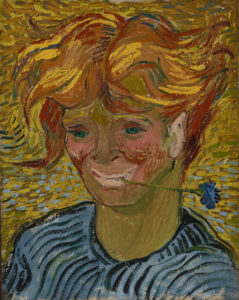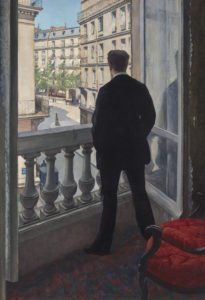Witnessing the events of Thursday November 11th at Christie’s New York was electrifying, to put it lightly. The 23-painting collection of the late Texas oil baron Edwin Cox, which included works by Van Gogh, Monet & Caillebotte, brought in $286 million ($332 million w/p), surpassing Christie’s presale estimate range of $178.6 to $267.6 million. Interestingly enough, the Edwin Cox collection is the most recent example of artists’ name recognition alone attracting big spenders to the auction houses.
Van Gogh’s Jeune homme au bleuet, or Young Man with a Cornflower, or, as I like to call it, Young Man in the Style of a Raggedy Anne Doll, is so jarring and unusual that it must’ve been Van Gogh’s name alone that caused it to sell for $40.5 million ($46.7 million w/p, est. $5 to $7 million). Of course, the fact that it was one of Van Gogh’s last works before his suicide in 1890 might add something to its value, but not exactly in the tens of millions. Frankly, Young Man with a Cornflower reaching such a ludicrous price is rather insulting to Van Gogh, whose catalogue raisonné is stocked with beautiful examples of portraiture, like those of the Roulin family, of Dr. Paul Gachet, or even his innumerable self-portraits executed throughout his life.
But while the offputting nature of the Van Gogh is detectable even through a computer screen, one of the other main attractions of sale had a secret that was a little more difficult to detect. Practically the centerpiece of the entire auction was Gustave Caillebotte’s Jeune homme à sa fenêtre, or Young Man at His Window. It is a striking and beautiful example of French realism, like many of Caillebotte’s works. Fortunately, Christie’s allows the public to view works about to go to auction, letting potential buyers examine the works up close. It’s good that auction houses like Christie’s keep this policy, since it would’ve allowed any interested parties the opportunity to spot the one major problem with the Caillebotte. Blacklight and extensive tests were not necessary; just the lights Christie’s set up in the galleries. If you got within ten feet of the Caillebotte, it became apparent that the work had been damaged. It appeared that the canvas had been slashed horizontally several times, then subsequently repaired and in-painted. And yet, despite the sloppy repair job, the painting was bought by the Getty Museum in Los Angeles for $46 million ($53 million w/p – est. in the region of $50 million).
There was also Claude Monet’s Nymphéas (fragment) which was a gift to Edwin Cox from Daniel Wildenstein in 1982 … I guess he spent enough money to warrant that! This rather unimpressive work with a stamped signature was expected to make anywhere between $700,000 and $1 million, yet sold for $5.2 million ($6.2 million w/p).
But the sale of the Edwin Cox collection wasn’t all about mistakes. It was a very good day for Gustave Loiseau, one of Impressionism’s most underrated stars. The two Loiseau paintings offered were definitely undervalued, with the $150,000 to $200,000 range being more appropriate than the under $50,000 range that Christie’s specialists had put down. However, I don’t think anyone expected them to exceed their estimates as exponentially as they did. Rocher la Teignouse, Cap Fréhel made $520,000 ($650,000 w/p – est. $30,000 to $50,000) and L’hôtel de Mademoiselle Ernestine, Saint-Jouin (Finistère) reached $620,000 ($774,000 w/p – est. $20,000 to $30,000).
It was a long sale, well over an hour for the 23 lots, all of which sold. While that’s certainly a good thing, it was also an expected result since Christie’s had a financial interest in all the works, and many were guaranteed by a third party. Can you really call that an auction when works are basically presold?
The Impressionist and Modern Art Day Sale, taking place on the Saturday after the Cox sale, also saw Loiseau’s continuing popularity. One of the two works tripled its $50,000 high estimate. The rest of the sale was nearly just as exciting, with a Renoir flower vase still life reaching nearly double the high estimate of $800,000, with a hammer price of $1.5 million ($1.83 million w/p). The Renoir was topped only by Joan Miró, whose Le serpent glisse vers l’azur parsemé de flèches brought in $2.3 million ($2.79 million w/p – est. $1 to $1.5 million). Many other works went far beyond their estimates, sometimes inexplicably. A painting of a goat by Henri Martin went for nearly six times its estimate; a Henri Lebasque landscape also hit a triple; and a Suzanne Valadon nude got $380,000 ($475,000 w/p), more than five times what experts predicted.
Other than the multimillion-dollar price tags, an unexpected highlight for anyone watching was a series of bidding wars in the middle of the sale. Two bidders, one on the phone, the other online, viciously fought over the three Max Ernst sculptures available. All were estimated to sell in the area of $30,000, so it came as a surprise when one bid after another drove the price for Masque aux yeux ronds up to $160,000 ($200,000 w/p). The fact that there were two parties with a particular interest in the Ernst sculptures only became apparent when La femme demi-tête, Ernst’s collaboration with Leonora Carrington, very quickly shot up to $90,000 ($112,500 w/p). Therefore, a bidding war over Ernst’s Sirène ailée was sort of expected, with presumably the same two bidders going back and forth until one of them eventually snagged it for $150,000 ($187,500 w/p), over four times what was predicted.|
The day sale was a pretty nice follow-up to the Cox collection, bringing in nearly $30 million and some interesting stories to go along with it.



